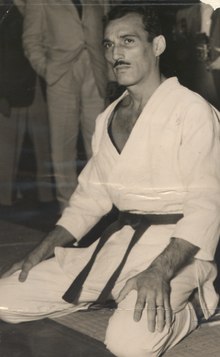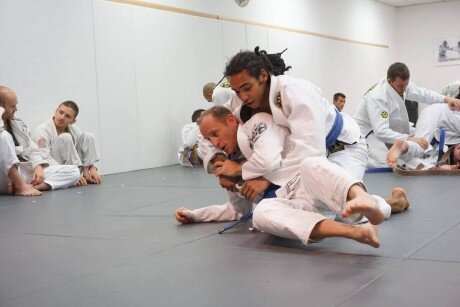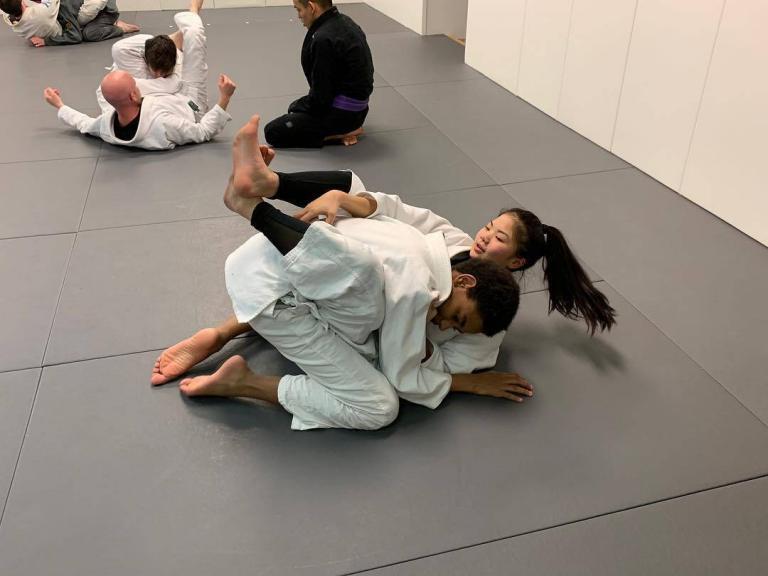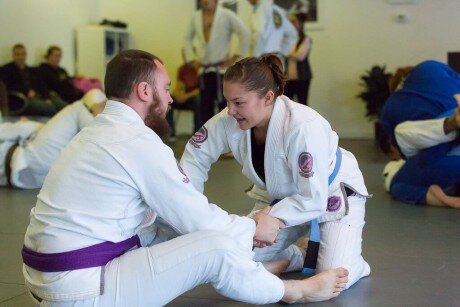BJJ stands for Brazilian Jiu-Jitsu. It is a martial art that specializes in grappling and submissions and originated by the Gracie family in Brazil in the early 1900s with its roots in Japanese Judo. Its popularity in the United States exploded in the 1990s when the Gracie family launched the UFC (Ultimate Fighting Championship) and Royce Gracie was pitted against martial artists from other disciplines to prove the effectiveness of Brazilian Jiu-Jitsu. The UFC and Mixed Martial Arts (MMA) evolved as a sport to incorporate the best techniques from multiple disciplines such as wrestling, judo, Thai boxing and boxing.

Brazilian Jiu-Jitsu is a grappling art which means that it focuses on takedowns, pins and submissions rather than punching or kicking. It is also unique in that there is a heavy focus on being able to win from your back by submission rather than just on the top position. Brazilian Jiu-Jitsu is traditionally practiced in the gi, but No-Gi Jiu-Jitsu is also popular where you train in shorts and a rash guard. Winning by submission is when you make your opponent tap out or give up by putting them in a choke, armlock or leglock. Brazilian Jiu-Jitsu is not just about winning, first you learn to defend yourself and stay safe and possibly outlast your opponent when you are the smaller than them.

Brazilian Jiu-Jitsu is the best martial art for kids and self defense because most fights end up going to the ground and end in grappling situations where other martial arts haven’t trained. This is backed up by studies from the army where Jiu-Jitsu is the taught in their combatives program. BJJ is also something that you can practice with full resistance unlike other martial arts like Krav Maga that rely on eye gouges that you can’t practice at 100% so you are just guessing on their effectiveness in a real life situation. Smaller people and kids won’t have the size and power to develop effective striking as seen in the lower rate of knockouts at lower weights of professional MMA and boxing matches.

BJJ is broken up into positions. Matches start from the standing position and involve takedowns like those seen in wrestling and judo. Dominant positions include the mount, back, side control and knee on belly. The person on top of a dominant position is looking to hold them down, submit them or transfer to another dominant position. Different guards exist such as the closed guard, open guard and half guard. From guard the person on top is looking to pass around the legs to a dominant position while the person on bottom can look to submit, sweep their opponent and gain the top position. General strategy in Jiu-Jitsu and in self-defense situations is to get on top and stay on top! If you are on your back, you hope to get to a guard and stay safe and possible sweep or submit.

You learn Brazilian Jiu-Jitsu by going to a Brazilian Jiu-Jitsu academy where they specialize in teaching the different techniques of Brazilian Jiu-Jitsu. Classes generally have a warm-up portion to get the body prepared to learn the techniques. Then a technical portion where different techniques are presented, usually from one position and perspective such as top of mount. Then there is some type of sparring or rolling where partners going against each other and try to practice what they learned from the day. Sparring is usually broken up into either specific training, also called positional training, where you one person would be training from the top of mount and the other person would be training from the bottom of mount. The person on bottom would be looking to escape and the person on top would be looking to hold the person down and submit them. They use their technique, strength and skill to beat the other person in what is commonly described as human chess. You can also do free training or sparring which starts on the knees or standing and it would go until a submission or time runs out. Usually beginners start with positional sparring until they get enough experience to have an idea of what to do from different positions. Advanced Jiu-Jitsu players also spend a tremendous time doing positional sparring because it allows them to spend more time honing in a very specific skill set.

Jiu-Jitsu practitioners are graded by belt ranks starting at white and going to black. People are graded based on their technical skill and ability on the mat. Usually a black belt takes between seven to twelve years to achieve. A blue belt is usually achieved between 1 and 2 years of practice a purple belt between 4 and 5 years and a brown in 6 to 8 years. Most black belts aren’t competitors and have day jobs that don’t involve BJJ at all. Children have a different belt system than adults and can not move to the adult belt system until they are 16 years old which helps keep the art different from many other martial arts with 10 year old black belts running around.

